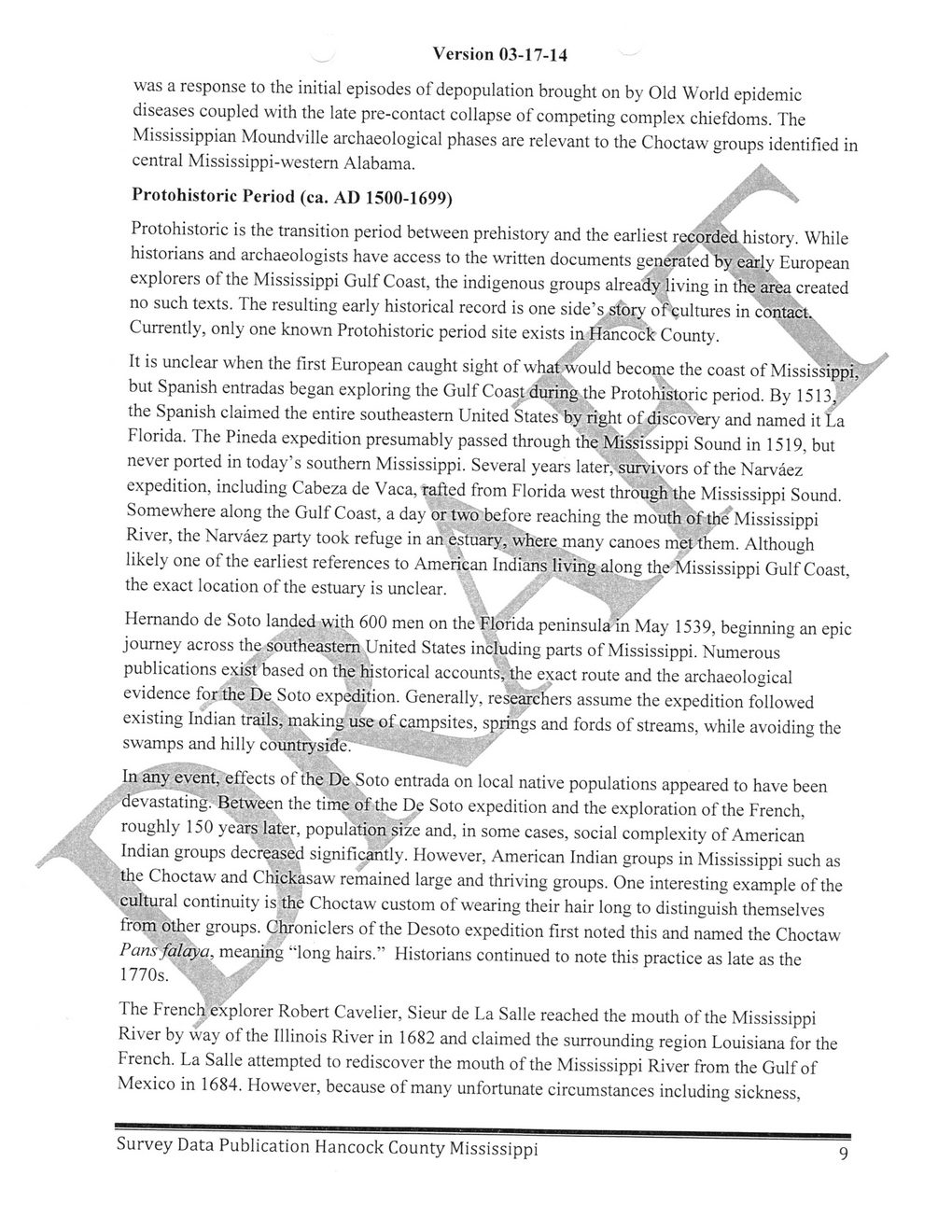This text was obtained via automated optical character recognition.
It has not been edited and may therefore contain several errors.
Version 03-17-14 was a response to the initial episodes of depopulation brought on by Old World epidemic diseases coupled with the late pre-contact collapse of competing complex chiefdoms. The Mississippian Moundville archaeological phases are relevant to the Choctaw groups identified in central Mississippi-western Alabama. Protohistoric Period (ca. AD 1500-1699) , v Protohistoric is the transition period between prehistory and the earliest recorded history. While historians and archaeologists have access to the written documents generated by early European explorers of the Mississippi Gulf Coast, the indigenous groups already living in the area created no such texts. The resulting early historical record is one side’s story ofcultures in contact^ Currently, only one known Protohistoric period site exists in Hancock County. . It is unclear when the first European caught sight of what would become the coast of Mississippi, ^ but Spanish entradas began exploring the Gulf Coast during the ProtohSstoric period. By 1513, the Spanish claimed the entire southeastern United States'by right of discovery and named it La Florida. The Pineda expedition presumably passed through the Mississippi Sound in 1519, but never ported in today’s southern Mississippi. Several years later,-survivors of the Narvaez expedition, including Cabeza de Vaca, rafted from Florida west through the Mississippi Sound. Somewhere along the Gulf Coast, a day or two'before reaching the mouth of the Mississippi River, the Narvaez party took refuge in an estuary, where many canoes met them. Although likely one of the earliest references to American Indians living along the Mississippi Gulf Coast, the exact location of the estuary is unclear. \ /' •, - / ■ Hernando de Soto landed with 600 men on the Florida peninsula in May 1539, beginning an epic journey across the southeastern United States including parts of Mississippi. Numerous publications exist based on the historical accounts, the exact route and the archaeological evidence for the De Soto expedition. Generally, researchers assume the expedition followed existing Indian trails, making use of campsites, springs and fords of streams, while avoiding the swamps and hilly countryside. ’ / In any event, effects of the De Soto entrada on local native populations appeared to have been devastating. Between the time of the De Soto expedition and the exploration of the French, roughly 150 years later, population size and, in some cases, social complexity of American Indian groups decreased significantly. However, American Indian groups in Mississippi such as the Choctaw and Chickasaw remained large and thriving groups. One interesting example of the cultural continuity is the Choctaw custom of wearing their hair long to distinguish themselves from other groups. Chroniclers of the Desoto expedition first noted this and named the Choctaw Pans falaya, meaning “long hairs.” Historians continued to note this practice as late as the 1770s. The French explorer Robert Cavelier, Sieur de La Salle reached the mouth of the Mississippi River by way of the Illinois River in 1682 and claimed the surrounding region Louisiana for the French. La Salle attempted to rediscover the mouth of the Mississippi River from the Gulf of Mexico in 1684. However, because of many unfortunate circumstances including sickness, Survey Data Publication Hancock County Mississippi 9

Hancock County History and Archeology Survey-Publication-Data-2014-(11)